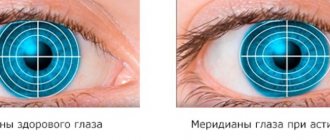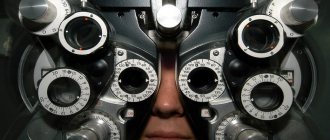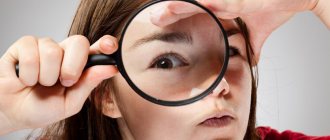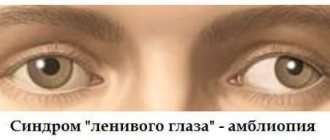A fairly common problem in ophthalmology is strabismus. It distinguishes varieties and types.
The appearance of congenital strabismus is possible when it is determined immediately after the birth of the baby or in the next year.
There may also be an acquired form, formed due to injury or decreased visual acuity.
Often with strabismus, the position of the eyeballs is approximately the same, so parents do not notice any changes in their children in early childhood. To check the defect at home, you can use several simple methods:
- block the healthy organ of vision, shake the toy away from the affected eye, if the baby has a reaction, the eyes are fine, if he does not pay attention to it, the risk of strabismus is high;
- if the child is older, diagnostic tests can be carried out using a pencil that is gradually moved away from the affected eye at a certain angle, the child must answer when he began to see it.
In other cases, with strabismus, the organs of vision deviate greatly from their normal location. Such a defect is immediately visible to the naked eye, so parents should immediately seek help from a doctor.
If parents suspect that their child has strabismus, they should immediately contact an ophthalmologist. He will conduct diagnostic tests:
- assessment of visual acuity using diagnostic tables;
- determination of binocular or monocular vision;
- assessment of the deviation of the affected eye at a certain angle;
- assessment of the visual perimeter.
Using these tests, you can not only make a diagnosis, but also identify the cause of strabismus.
It is this that must be eliminated in order to prevent relapse of the disease. For example, if strabismus develops as a result of severe myopia in one eye, it is necessary to completely restore visual function so that after treatment the eye does not deviate from the normal axis again.
Once the cause is established, treatment begins. There are 4 types of therapy for strabismus.
- Gymnastics for the eyes. Exercises must be performed daily. If a person often uses computer gadgets or reads texts, it is recommended to do so every few hours. With their help, the oculomotor muscles begin to function, and the affected organ of vision becomes tense.
- Hardware treatment. Special ophthalmic devices are used, with the help of which the oculomotor muscles begin to function. They are all based on the same principle. A healthy organ of vision is blocked. The load is applied only to the affected eye. Pictures appear on the monitor and begin to move. The affected eye begins to strain to try to see the image.
- Bandage on the good eye. Fabric materials or basic ones with Velcro are used. It is necessary to block the healthy organ of vision so that the affected eye begins to gradually start working.
- Surgery. It is used if the patient has a strong deviation in the angle of vision, conservative treatment does not work, and the person does not want to wait many years for the effect to appear. With the help of surgery, the doctor tightens the extraocular muscles in the desired position, and the eye restores its normal location.
In an approach to eye treatment, a comprehensive approach is important. Conservative therapy can last for many years. Therefore, if a defect is detected in a child, treatment must be started immediately. Strabismus is also a cosmetic defect, so parents must explain to the child how to live and exist with it in order to improve his standard of living.
Causes and predisposing factors
The statistics are disappointing. Since every second inhabitant of the planet is diagnosed with eye diseases. This prevalence of eye pathologies is primarily associated with the regular use of a computer, telephone and other gadgets.
Other causes of eye diseases:
- reading in poor lighting;
- focusing on objects that are too close;
- infectious pathogens (in 70% of cases of inflammation due to viruses);
- allergens;
- deficiency of nutrients due to an unbalanced diet;
- eye injuries;
- age-related changes, aging of eye tissues;
- chronic diseases, for example, diabetes, high blood pressure.
As a rule, office workers, IT specialists, and typists are more likely to be at risk for eye diseases. Since their work involves a computer, the risk of dry eye syndrome, computer syndrome and other problems increases. In addition, seamstresses, people who do handicrafts, and drivers are at risk.
If we talk about cataracts and glaucoma, then patients older than 50-60 years are undoubtedly at risk. As well as people with diabetes, cardiovascular diseases, and increased intraocular pressure.
Of course, heredity plays an important role. For example, some eye diseases, such as myopia and glaucoma, are inherited. If you have a hereditary predisposition, you should protect your eyes even more from negative factors. In particular, work less on the computer and watch TV, and maintain personal hygiene.
Depending on the origin, all eye diseases are divided into congenital and acquired. The first arise due to genetic mutations, as well as intrauterine developmental anomalies. Unlike acquired diseases, congenital diseases are difficult to treat.
When the eyes don't agree.
When the eyes don't agree.
In everyday psychology it has always been believed that if a person’s gaze is direct and open, then he himself is like that. Conversely, a shifting gaze always reveals a liar. But what about the case when the eyes cannot see straight due to illness? There is only one answer - to correct strabismus. And pediatric ophthalmologist, Candidate of Medical Sciences Petr Petrovich SKRIPETS will tell you how to do this.
— Petr Petrovich, is it possible to diagnose strabismus in a child at home?
- It is not difficult to identify this disease. Sit opposite the child and look him 'eye to eye'. A light source (a window behind you, a lamp or flashlight in front of you) is directed into the child's face so that both of his eyes are illuminated. At the same time, in the child’s eyes you will see a reflection of the light source in the form of white luminous dots.
If the reflection is in the middle of the pupils (a black hole in the iris in the middle of the eye), then there is no strabismus; if one of the reflections is shifted to the side, the eye is squinting.
— How does strabismus manifest itself?
— There are various forms and types of strabismus. Explicit strabismus, or heterotropia, is characterized by the deviation of one of the eyes from the common point of fixation and a violation of binocular (that is, three-dimensional) vision. This disease is associated with profound oculomotor disorders. It is divided into two types: friendly and paralytic.
Concomitant strabismus occurs in 25-40 percent of all children who squint. It is caused by disturbances between accommodation (focusing) and convergence (simultaneous pointing of both eyes at an object).
With this form, either the left or the right eye squints. At the same time, the full range of movements of the eyeballs is preserved, there is no double vision, the angle of deviation of the squinting eye when it is included in the visual process is almost always equal to the angle of deviation of the fellow eye, and binocular vision is impaired.
The absence of double vision is explained by the fact that the healthy eye completely takes over the work of the squinting eye, especially when the patient looks with both eyes. If you close one eye, vision in the other is immediately restored. This indicates the central, cortical nature of visual inhibition.
If a child sees poorly, the conditions for accommodation (adaptation of the eyes to certain conditions) change: with high farsightedness, accommodation becomes excessive, with myopia - insufficient. In this way, inconvenience is created for the joint work of both eyes, binocular vision is difficult, and the image of one of the eyes is suppressed by consciousness.
Naturally, the image coming from the eye with lower visual acuity also changes. At first, the squinting eye deviates periodically, then constantly. The result is monolateral (one-sided) strabismus. Gradually, visual acuity in the squinting eye decreases even more, and amblyopia develops - when the eye completely refuses to work.
— What is the peculiarity of paralytic strabismus?
— In the paralytic form, only one eye always squints. This is due to paralysis or paresis of the extraocular muscles. This pathology can occur as a result of hemorrhages, tumors, injuries, and intoxications.
A characteristic sign of paralytic strabismus is limited mobility of the squinting eye towards the affected muscle. As a result, diplopia (double vision) appears, which intensifies when looking in the same direction.
—Can one eye squint first, then the other?
- With the same visual acuity, alternating (intermittent) strabismus usually occurs, when the eyes squint alternately. This is due to the fact that the cerebral cortex suppresses the image of one or the other eye.
— How is the angle of strabismus determined?
— The amount of deviation of the eye, that is, the angle of strabismus, is expressed in degrees and determined by various methods. The simplest of them is the Hirshberg method.
It consists of asking the patient to fixate the light source with his gaze. The reflection of light on the cornea of a healthy eye will coincide with the center of the pupil; on a squinting eye it will be shifted.
If, with a pupil width of 3 mm, the corneal reflection of light is located along the edge of the pupil, then the angle of strabismus will be 15 degrees, between the edge of the pupil and the limbus - 25-30, on the limbus - 45, behind the limbus - 60 or more.
— How is the disease treated?
— Treatment of paralytic strabismus should be aimed, first of all, at eliminating the cause that caused the damage to the muscle or nerve. Often it is necessary to resort to surgical treatment. To eliminate ghosting, prismatic glasses are prescribed.
With the concomitant form, it is important to determine whether the strabismus is accommodative or non-accommodative.
Non-accommodative strabismus usually develops during the first year of life. It should be considered one of the symptoms of cerebral palsy. The disease is based on paresis of the oculomotor muscles caused by intrauterine or birth trauma. With this form of the disease, only surgery will help.
Accommodative strabismus can be corrected with glasses and partially accommodative strabismus is reduced. Glasses are prescribed for constant wear by children from 6-9 months. Treatment usually lasts about 2-3 years.
— Do you have to wear glasses all the time?
- Yes. In parallel with spectacle correction for unilateral strabismus, pleoptic treatment is carried out. Its task is to improve the visual acuity of a squinting eye.
One of the methods is direct occlusion - gluing, that is, turning off the better seeing eye from visual perception. This method is used for many months, but it is effective only up to 5-6 years of age.
To restore central fixation in an unhealthy eye, other, more active methods are used: light stimulation and laser stimulation of the macular area, electrical stimulation of the retina and optic nerve.
When the visual acuity of the amblyopic eye can be raised to 0.4 and a parallel position of the visual lines is achieved, orthoptic treatment is started. To do this, classes are conducted on a synaptophore and a stereoscope.
— What if conservative treatment turns out to be ineffective?
— If, while wearing glasses and after a set of pleoptoorthoptic exercises, strabismus is not eliminated by 4-5 years of age, they resort to surgical intervention. It is aimed at either weakening a strong muscle (the one towards which the eye is tilted) or strengthening the action of a weak one, that is, the opposite one. In some cases, combined operations are used. Postoperative treatment is aimed at restoring and strengthening binocular vision.
Ekaterina QUEEN.
Types of eye diseases
You might be surprised, but there are more than 2 thousand eye diseases. Most often, people go to the hospital with “dry eye syndrome,” farsightedness, myopia, and conjunctivitis. In older patients, cataracts and glaucoma are most often diagnosed.
Note! Eye diseases are treated by an ophthalmologist or ophthalmologist. There is no difference between these doctors.
The eye is a complex organ of the visual system. A huge number of structures are involved in the process of obtaining a picture of the surrounding world:
- the eyeball, most of which is filled with vitreous humor;
- the outer shell, which includes the cornea and sclera;
- the retina and its central part - the macula;
- choroid, which consists of the iris, ciliary body and choroid;
- lens;
- pupil.
The normal functioning of the eye is ensured by blood vessels, extraocular muscles, the optic nerve and lacrimal glands. The protective function is performed by the eyelids and eyelashes.
Is it harmful to work with a monitor for a long time?
Today the situation is much better than before. Modern monitors are quite safe for the eyes. The danger is that the eye focuses at a close distance, which can cause overwork of the intraocular muscle. It's important to take breaks every 40 minutes - no openings.
Also, while working, you need to think about lighting, that is, sitting at the monitor with the lights off is harmful. This may lead to changes in the retina. Therefore, if you need to work with gadgets for a long time, do not forget about background lighting. This will significantly reduce eye strain.
By the way, when working at a computer, visual monitor syndrome may appear - this is a set of unpleasant sensations in the eye that develops as a result of prolonged work with gadgets.
After all, in order to feel comfortable, the eye must be moisturized. Otherwise, there is a feeling of a foreign body in the eye, it seems that sand has got into it, and there is a desire to close your eyes. This happens because a person who is passionate about work begins to blink less often. Ideally, we should blink every 5 seconds. Screen work and high concentration do not allow us to do this.
If visual monitor syndrome still overtakes you, you can use special drops. They will help solve the problem of eye hydration. And no, this syndrome will not make you blind. An ophthalmologist will always tell you which drops are best.
Diagnosis and treatment
At the appointment, the doctor examines the eyeball, measures pressure, and determines visual acuity. Then, using special equipment, it evaluates the thickness of the cornea, lens, and assesses the condition of other membranes.
After making a diagnosis, the ophthalmologist selects the most effective treatment method. Of course, therapy depends on the disease. This can be either eye drops, ointments or injections, or laser intervention. In addition, physiotherapeutic procedures are used. For example, electrophoresis and magnetophoresis are effective.
It is important to treat eye diseases on time, because otherwise you can live the rest of your days in complete darkness. Make an appointment with an ophthalmologist as soon as the first signs appear.
Express Your Reaction
Similar articles:
Cataract - the story of one operation
The editors of Health Expert received a letter from our reader: “At the age of 58, my mother developed an ear infection...
Contact lenses
Today, the most affordable and convenient way to correct vision is contact lenses. H...
An insidious disease - glaucoma
The human eye is a unique optical device given to us by nature itself. It is known that full...
Myopia goes away without surgery - truth or myth?
“One hundred percent vision without glasses or contacts!” - such tempting promises beckon us from the covers...
A cataract, or leukoma, is a spot on the cornea of the eye.
A cataract or leukoma is a spot on the eye that appears due to clouding of the cornea. It's in…
Horner's syndrome - when the eyelid does not obey
Horner's syndrome In the lives of each of us there are good friends from whom we want to follow an example. Eat …
Is it harmful to watch welding?
Let's go from afar: we all see the light. Light is electromagnetic radiation. It consists of waves of different lengths. Everything that we catch with our eyes is called visible light. What we don't notice is infrared and ultraviolet radiation. Only ultraviolet light is dangerous to vision. This is what is present in electric welding. Ultraviolet radiation has little penetrating power, but high energy. Accordingly, when a person looks at welding, ultraviolet radiation burns the surface layer of the cornea. The symptoms of this condition are familiar to many: photophobia, lacrimation, desire to close the eyes. It is logical that because of this, a shield is used when working with welding.
The main recommendations here are to protect your eyes from ultraviolet radiation. Do not look at welding, do not work without protection. This also applies, for example, to solariums. This situation certainly does not cause blindness, and the condition itself goes away quite quickly. The cornea is restored well with the help of special drops; this process takes less time. If you still encounter such a problem, do not panic, but seek advice from a specialist.











